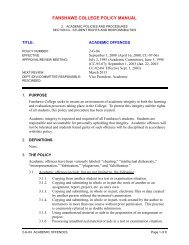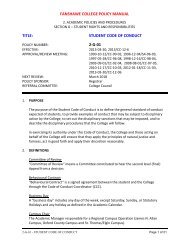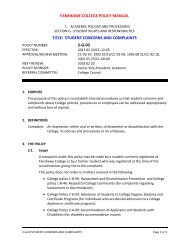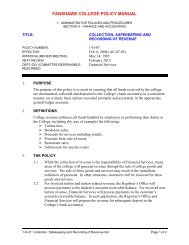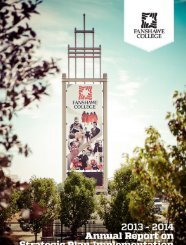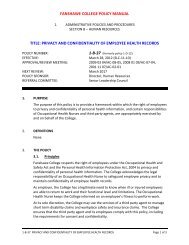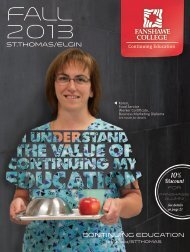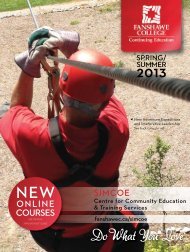ALUMNI News - Fanshawe College
ALUMNI News - Fanshawe College
ALUMNI News - Fanshawe College
You also want an ePaper? Increase the reach of your titles
YUMPU automatically turns print PDFs into web optimized ePapers that Google loves.
INTERNATIONAL NEWS<br />
12<br />
“I would strongly<br />
recommend this kind of<br />
exchange program,” says<br />
Wendy. “I know I am a<br />
better teacher. I’m not only<br />
bringing home new course<br />
materials on textiles, but<br />
certainly a<br />
deeper level<br />
of skill...”<br />
When <strong>Fanshawe</strong> was offered the<br />
chance to deliver its world-class<br />
Fashion Design program in India, the<br />
opportunity was a perfect fi t. The<br />
<strong>College</strong> was already well into a strategic<br />
plan to internationalize that began<br />
in the mid-90s. Through concerted<br />
efforts, recruitment levels had risen to<br />
more than 300 international students<br />
each year and exchange programs<br />
and international partnerships were<br />
fl ourishing.<br />
What worked so well in this case<br />
was that Georgian <strong>College</strong> in Barrie,<br />
Ontario already had a viable working<br />
arrangement with CIIS, the Canadian<br />
Institute for International Studies, in<br />
Chandigarh in the Punjab state in North<br />
India. The modern campus of about 650<br />
full-time students focuses on delivering<br />
North American diploma and degree<br />
programs. <strong>Fanshawe</strong> became a partner<br />
with Georgian and CIIS in 2005.<br />
It is a very attractive feature to Indian<br />
students that the curriculum at CIIS is<br />
equivalent to what the student would<br />
be learning in Canada. Their diploma in<br />
Fashion Design will be from <strong>Fanshawe</strong><br />
<strong>College</strong> and students may transfer to<br />
study at <strong>Fanshawe</strong> in Canada and get<br />
full standing for their credits.<br />
One key step was selecting a<br />
<strong>Fanshawe</strong> professor willing to travel<br />
to India and work for the year. Enter<br />
Wendy Sperry, a 17-year veteran within<br />
<strong>Fanshawe</strong>’s Fashion Merchandising and<br />
Fashion Design programs. She taught<br />
part-time in London for 13 years and<br />
full-time for the past four years. For<br />
many of those years, she also ran her<br />
own business, designing, manufacturing<br />
and marketing a high-end line of<br />
children’s clothing.<br />
When she arrived in Chandigarh<br />
in August 2005, she was warmly<br />
welcomed by her Georgian colleagues,<br />
her Indian hosts, and her fresh-faced<br />
students. India is the world’s 12th<br />
largest economy with a population of<br />
one billion. While its fashion design<br />
industry is only about 10 years old,<br />
it is growing exponentially within an<br />
incredibly rich textile base. Textiles form<br />
a huge part of the national economy<br />
and culture in India.<br />
As program coordinator and<br />
professor, Wendy got the program up<br />
and running at CIIS. She purchased<br />
equipment, hired staff, interviewed<br />
students, and even worked with<br />
carpenters to build the design studio.<br />
She mentors other staff members so<br />
that they understand the <strong>Fanshawe</strong><br />
curriculum and Canadian teaching<br />
methods.<br />
Admittedly the work environment<br />
is quite different. Virtually everyone<br />
speaks either Hindi or Punjabi with<br />
very little spoken English. There is a<br />
strictly defi ned level of hierarchy, so no<br />
one wants to take action without an<br />
OK from the top. “One strange thing<br />
that happens almost daily in India is<br />
power outages,” says Wendy. “Now,<br />
we don’t even notice if the lights go<br />
out except in sewing class.”<br />
The assignment has been<br />
challenging both personally and<br />
professionally. “I am away from<br />
everything I know and love,<br />
especially my family, which has been<br />
pretty hard at times,” she admits.<br />
“Plus there is such a lack of privacy<br />
and autonomy. Indians would not<br />
even understand these concepts but I<br />
miss them dearly.”<br />
While her Indian students seem<br />
younger and have different priorities<br />
in terms of their education and<br />
career, they have become very<br />
dear to her heart. “It is culturally<br />
unacceptable for students to hold part<br />
time jobs. They’ve had servants all<br />
their lives and most still live at home<br />
with their parents,” says Wendy.<br />
“Since their educational system is<br />
based largely on memorization,<br />
our type of hands-on learning and<br />
creative thinking is new for them.<br />
But I must say they like it and have<br />
adjusted well.”<br />
Students in India tend to work<br />
as a unit not as individuals. Wendy<br />
has had to adapt her teaching style<br />
because they all want to do every<br />
assignment together. “Their approach<br />
means that the whole class will make<br />
the same mistakes on the assignment<br />
so I have to watch for that.”<br />
Overall, Wendy feels she has<br />
connected very well with her<br />
students. They are quite sensitive<br />
to her needs and really seem to<br />
appreciate what she is giving them in<br />
terms of knowledge and skill.<br />
As she prepared to return home in<br />
May, she refl ected on an incredible<br />
year. “I would strongly recommend<br />
this kind of exchange program,”<br />
says Wendy. “I know I am a better<br />
teacher. I’m not only bringing home<br />
new course materials on textiles but<br />
certainly a deeper level of skill in<br />
dealing with international students.”<br />
<strong>Fanshawe</strong> <strong>College</strong> Alumni <strong>News</strong> Spring 2006





